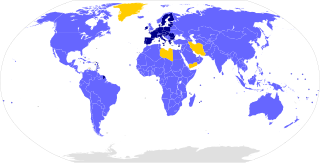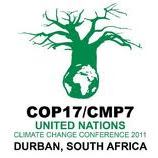Related Research Articles

The Kyoto Protocol (Japanese: 京都議定書, Hepburn: Kyōto Giteisho) was an international treaty which extended the 1992 United Nations Framework Convention on Climate Change (UNFCCC) that commits state parties to reduce greenhouse gas emissions, based on the scientific consensus that global warming is occurring and that human-made CO2 emissions are driving it. The Kyoto Protocol was adopted in Kyoto, Japan, on 11 December 1997 and entered into force on 16 February 2005. There were 192 parties (Canada withdrew from the protocol, effective December 2012) to the Protocol in 2020.

The United Nations Framework Convention on Climate Change (UNFCCC) is the UN process for negotiating an agreement to limit dangerous climate change. It is an international treaty among countries to combat "dangerous human interference with the climate system". The main way to do this is limiting the increase in greenhouse gases in the atmosphere. It was signed in 1992 by 154 states at the United Nations Conference on Environment and Development (UNCED), informally known as the Earth Summit, held in Rio de Janeiro. The treaty entered into force on 21 March 1994. "UNFCCC" is also the name of the Secretariat charged with supporting the operation of the convention, with offices on the UN Campus in Bonn, Germany.
The Clean Development Mechanism (CDM) is a United Nations-run carbon offset scheme allowing countries to fund greenhouse gas emissions-reducing projects in other countries and claim the saved emissions as part of their own efforts to meet international emissions targets. It is one of the three Flexible Mechanisms defined in the Kyoto Protocol. The CDM, defined in Article 12 of the Protocol, was intended to assist non-Annex I countries achieve sustainable development and reduce their carbon footprints, and to assist Annex I countries achieve compliance with greenhouse gas emissions reduction commitments.
Flexible mechanisms, also sometimes known as Flexibility Mechanisms or Kyoto Mechanisms, refers to emissions trading, the Clean Development Mechanism and Joint Implementation. These are mechanisms defined under the Kyoto Protocol intended to lower the overall costs of achieving its emissions targets. These mechanisms enable Parties to achieve emission reductions or to remove carbon from the atmosphere cost-effectively in other countries. While the cost of limiting emissions varies considerably from region to region, the benefit for the atmosphere is in principle the same, wherever the action is taken.

Land use, land-use change, and forestry (LULUCF), also referred to as Forestry and other land use (FOLU) or Agriculture, Forestry and Other Land Use (AFOLU), is defined as a "greenhouse gas inventory sector that covers emissions and removals of greenhouse gases resulting from direct human-induced land use such as settlements and commercial uses, land-use change, and forestry activities."
After the 2007 United Nations Climate Change Conference held on the island of Bali in Indonesia in December 2007, the participating nations adopted the Bali Road Map as a two-year process working towards finalizing a binding agreement at the 2009 United Nations Climate Change Conference in Copenhagen, Denmark. The conference encompassed meetings of several bodies, including the 13th session of the Conference of the Parties to the United Nations Framework Convention on Climate Change and the third session of the Conference of the Parties serving as the meeting of the Parties to the Kyoto Protocol.
The Copenhagen Accord is a document which delegates at the 15th session of the Conference of Parties to the United Nations Framework Convention on Climate Change agreed to "take note of" at the final plenary on 18 December 2009.

The 2010 United Nations Climate Change Conference was held in Cancún, Mexico, from 29 November to 10 December 2010. The conference is officially referred to as the 16th session of the Conference of the Parties (COP 16) to the United Nations Framework Convention on Climate Change (UNFCCC) and the 6th session of the Conference of the Parties serving as the meeting of the Parties (CMP 6) to the Kyoto Protocol. In addition, the two permanent subsidiary bodies of the UNFCCC — the Subsidiary Body for Scientific and Technological Advice (SBSTA) and the Subsidiary Body for Implementation (SBI) — held their 33rd sessions. The 2009 United Nations Climate Change Conference extended the mandates of the two temporary subsidiary bodies, the Ad Hoc Working Group on Further Commitments for Annex I Parties under the Kyoto Protocol (AWG-KP) and the Ad Hoc Working Group on Long-term Cooperative Action under the Convention (AWG-LCA), and they met as well.
The Kyoto Protocol was an international treaty which extended the 1992 United Nations Framework Convention on Climate Change. A number of governments across the world took a variety of actions.
The Kyoto Protocol was an international treaty which extended the 1992 United Nations Framework Convention on Climate Change.
United Nations Secretary-General Ban Ki-moon established a High-Level Advisory Group on Climate Change Financing (AGF) on 12 February 2010 for the duration of ten months. The group's aim was to "study potential sources of revenue that will enable achievement of the level of climate change financing that was promised during the United Nations Climate Change Conference in Copenhagen in December 2009."

The Paris Agreement is an international treaty on climate change that was signed in 2016. The treaty covers climate change mitigation, adaptation, and finance. The Paris Agreement was negotiated by 196 parties at the 2015 United Nations Climate Change Conference near Paris, France. As of February 2023, 195 members of the United Nations Framework Convention on Climate Change (UNFCCC) are parties to the agreement. Of the three UNFCCC member states which have not ratified the agreement, the only major emitter is Iran. The United States withdrew from the agreement in 2020, but rejoined in 2021.

The 2011 United Nations Climate Change Conference (COP17) was held in Durban, South Africa, from 28 November to 11 December 2011 to establish a new treaty to limit carbon emissions.
Brazil has established a strong public policy using Clean Development Mechanism Projects to reduce methane emissions from landfills. An important component of these projects is the sale of avoided emissions by the private market to generate revenue.

The Green Climate Fund (GCF) is a fund for climate finance that was established within the framework of the United Nations Framework Convention on Climate Change (UNFCCC). Considered the world's largest fund of its kind, GCF's objective is to assist developing countries with climate change adaptation and mitigation activities. The GCF is an operating entity of the financial mechanism of the UNFCCC. It is based in Songdo, Incheon, South Korea. It is governed by a Board of 24 members and supported by a Secretariat.

Climate finance is an umbrella term for financial resources such as loans, grants, or domestic budget allocations for climate change mitigation, adaptation or resiliency. Finance can come from private and public sources. It can be channeled by various intermediaries such as multilateral development banks or other development agencies. Those agencies are particularly important for the transfer of public resources from developed to developing countries in light of UN Climate Convention obligations that developed countries have.

The 2012 United Nations Climate Change Conference was the 18th yearly session of the Conference of the Parties (COP) to the 1992 United Nations Framework Convention on Climate Change (UNFCCC) and the 8th session of the Meeting of the Parties (CMP) to the 1997 Kyoto Protocol. The conference took place from Monday 26 November to Saturday 8 December 2012, at the Qatar National Convention Centre in Doha.

The United Nations Climate Change Conferences are yearly conferences held in the framework of the United Nations Framework Convention on Climate Change (UNFCCC). They serve as the formal meeting of the UNFCCC parties – the Conference of the Parties (COP) – to assess progress in dealing with climate change, and beginning in the mid-1990s, to negotiate the Kyoto Protocol to establish legally binding obligations for developed countries to reduce their greenhouse gas emissions. Starting in 2005 the conferences have also served as the "Conference of the Parties Serving as the Meeting of Parties to the Kyoto Protocol" (CMP); also parties to the convention that are not parties to the protocol can participate in protocol-related meetings as observers. From 2011 to 2015 the meetings were used to negotiate the Paris Agreement as part of the Durban platform, which created a general path towards climate action. Any final text of a COP must be agreed by consensus.
Climate finance in Kenya is vital to meet its climate goals and ensure sustainable economic growth. By leveraging international and domestic funding sources, Kenya can continue its leadership in renewable energy, climate adaptation, and building a resilient economy that can withstand the effects of climate change.
References
- ↑ "Decision 1/CMP.3: Adaptation Fund" (PDF). Archived from the original (PDF) on 2012-03-10. Retrieved 2011-01-05.
- ↑ "Decision 10/CP.7: Funding under the Kyoto Protocol" (PDF). Archived (PDF) from the original on 2018-01-17. Retrieved 2011-01-05.
- ↑ "Operational policies and guidelines for Parties to access resources from the Adaptation Fund" (PDF).
- 1 2 "Adaptation Fund Trust Fund" (PDF). www.worldbank.org. Archived from the original on January 7, 2014.
- ↑ "Fund Details". Archived from the original on 2014-01-07. Retrieved 2014-01-06.
- ↑ "Rwanda, Pacific Islands to benefit from Adaptation Fund support | Adaptation Fund". Archived from the original on 2014-01-06. Retrieved 2014-01-06.
- ↑ "Adaptation Fund Board approves more projects as adaptation demand grows". 9 October 2015. Archived from the original on 8 February 2017. Retrieved 7 December 2015.
- ↑ "Adaptation Fund". Archived from the original on 2023-08-14. Retrieved 2023-12-16.
- 1 2 3 afadmin. "About". Adaptation Fund. Retrieved 2024-04-25.
- ↑ "Adaptation Fund surpasses $100 million fundraising target at COP19". Archived from the original on 2014-01-06. Retrieved 2014-01-06.
- ↑ "Adaptation Fund FAQs". Archived from the original on 2016-01-21. Retrieved 2015-12-07.
- ↑ "Adaptation Fund official website". Archived from the original on 2011-01-01. Retrieved 2011-01-05.
- ↑ "About the Adaptation Fund - Governance". Archived from the original on 2016-01-21. Retrieved 2015-12-07.
- ↑ "Direct Access". Archived from the original on 2016-01-20. Retrieved 2015-12-07.
- 1 2 "EBSCO Sign In". login.ebsco.com.
- 1 2 "EBSCO Sign In". login.ebsco.com.